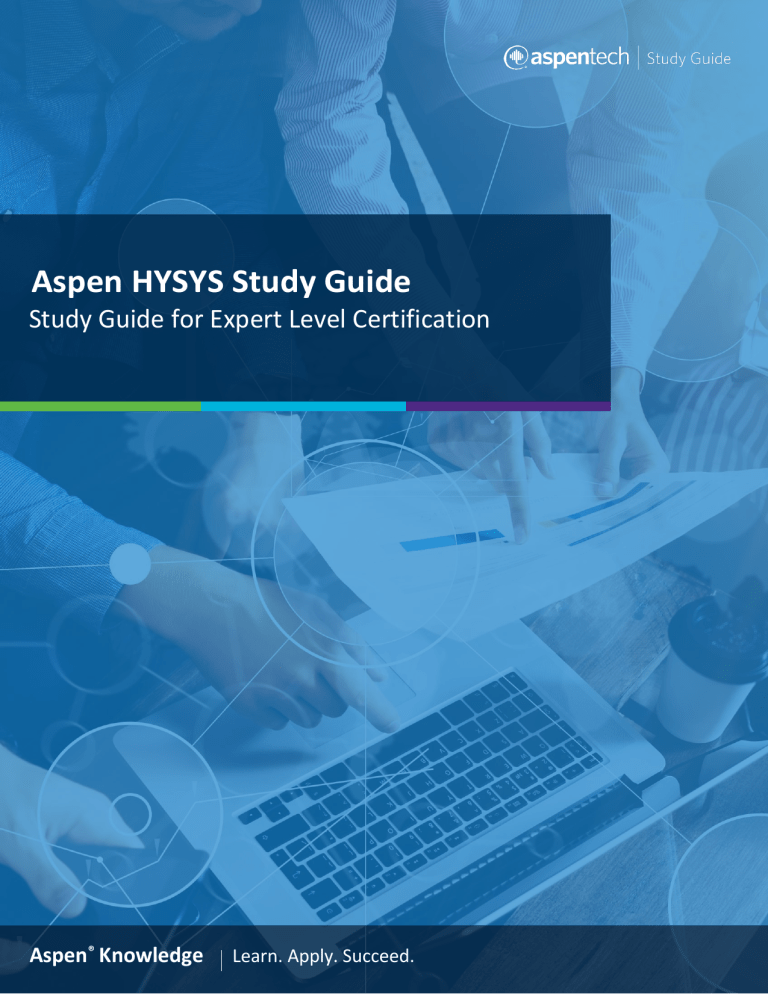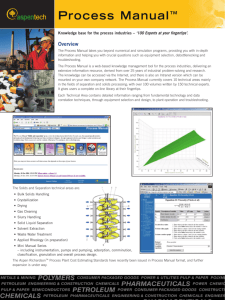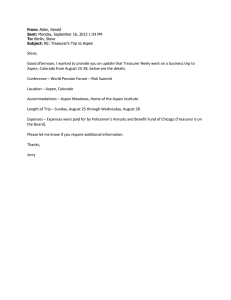
Aspen HYSYS Study Guide Study Guide for Expert Level Certification Aspen® Knowledge Learn. Apply. Succeed. Prove Your Credibility An Aspen Certified Expert User in Aspen HYSYS demonstrates skills required to build complex models associated to Upstream, Midstream and Safety applications, and interpret results of a simulation with little guidance. For the lab section of the exam, midstream application and column models will be required; however, you will be able to choose between upstream application and safety analysis. Practice AspenTech training is highly recommended though not required. Exam Scope for Aspen HYSYS □ □ □ □ Midstream Application Upstream Application Safety Analysis Column Models Grading Grade Multiple choice questions Lab task Total Weight 30% This guide contains 100% coverage of all objectives for the certification exam. You can use it as both a study tool and an on-the job reference (read pages 2-3). Get Certified In-person and remote testing are available. Please make sure that you select the correct Location/Time Zone. After passing the exam you will receive an email to post your certificate and digital badge on social media, which is a cross-industry recognition of technical skills you may share on LinkedIn, as well as in your email signature. View the instructions on how to post your credentials on LinkedIn profile. 70% 100% AspenTech Call | Email | Chat Aspen Technology, Inc. All rights reserved. 1 SCOPE TECHNICAL CONTENT TEST OBJECTIVES Identify the components supported by Acid Gas Fluid Packages Identify the characteristics of the Acid Gas Fluid Packages Acid Gas Process Overview & Workflow Midstream applications in Aspen HYSYS Gas Dehydration Process Overview & Workflow Sulfur Recovery (SULSIM) Process Overview & Workflow Aspen Technology, Inc. All rights reserved. Demonstrate the key differences between the available Acid Gas Column calculation options and illustrate how to set up the column for these calculations. Locate result forms exclusive to the Acid Gas columns Troubleshoot common acid gas column convergence issues. Summarize the most commonly used unit operations in acid gas cleaning processes. Configure case studies using variables from the acid gas unit operations Demonstrate how to configure acid gas makeup blocks Perform detailed sizing and rating calculations using the Column Analysis workflow for your acid gas column. Recognize which Fluid Packages are suitable for gas dehydration systems Review methods for saturating a hydrocarbon stream with water in Aspen HYSYS Identify the wokflow to calculate Water Dew Point of a stream Utilize the Hydrate Formation Analysis to calculate hydrate formation temperatures and pressures Identify the supported hydrate inhibitors in Aspen HYSYS Set up the necessary unit operations to model a typical gas dehydration unit and study gas saturation. Analyze and display the results to further optimize the dehydration process. Identify the characteristics for the Sulsim Fluid Package Explore the unit operations that conform different stages involved in sulfur recovery process. Configure the thermal and catalytic stages process units available in Sulsim. Specify Reaction Furnace Parameters and select an Empirical Furnace Model appropriate for your feed conditions. Define Degasser and Tail Gas Treating Section unit operations. Create or import Sulfur Recovery Unit (SRU) sub-flowsheets. Review the performance summary form to explore the various production and efficiency values for the trains and stages. Specify an Air Demand Analyzer and how to set up and run it. Build the SRU flowsheet using Add Combinations group to add a group of unit operations organized in pre-configured topologies for the thermal, catalytic and tail gas treating sections. 2 SCOPE TECHNICAL CONTENT TEST OBJECTIVES Recognize which Fluid Packages are suitable for systems with acid water Midstream applications in Aspen HYSYS Sour Water Process Overview & Workflow' Aspen HYSYS Pipe Segments Upstream applications in Aspen HYSYS Linse Sizing Utility Hydraulics Aspen Technology, Inc. All rights reserved. Identify the characteristics of the Sour Water Fluid Packages Identify the phenomena on the components and ions in Sour Water systems Identify the key differences between the available calculation options and illustrate how to set up the Sour Water Stripping Column Parameters. Identify the different pipe models available in Aspen HYSYS and their respective applications Summarize the available pressure drop correlations and the workflow to adjust it in a pipe segment Locate the different result sections available in the pipe segment operation Identify the available heat transfer calculations to calculate heat loss in a pipe and recognize the workflow to configure each Summarize the available flow assurance analyses on the pipe operation and the steps to configure them Illustrate the functionality of the Line Sizing utility Summarize the workflow to run this analysis Distinguish between the key differences of Aspen HYSYS Pipe Segment and Aspen Hydraulics Identify the types of systems that can be best represented using Aspen Hydraulics Recognize the supported fluid packages in Aspen Hydraulics and the workflow to change the defaulr model Identify the available heat transfer calculations to calculate heat loss in a pipe and recognize the workflow to configure each Summarize the available flow assurance analyses on the pipe operation and the steps to configure them Configure the flowsheet constraints in an Aspen Hydraulics model 3 SCOPE TECHNICAL CONTENT General Scenarios Safety Analysis in Aspen HYSYS Fire Scenarios Multiple relief devices Line Sizing PSV Datasheets Column Operations in Aspen HYSYS Column Models in Aspen HYSYS Troubleshoot Columns Modeling External Unit Operations for Columns Column Internals in Aspen HYSYS TEST OBJECTIVES Illustrate the workflow and steps required to create and configure a PSV Illustrate the steps that should be followed to configure a scenario Recognize the scenarios that allow relieving flow calculations Identify the application of each sizing method based on scenario conditions Illustrate the steps that should be followed to configure a fire scenario Identify the available flow calculation methods for vessels with Liquid, Vapor and Supercritical fluids Illustrate how to obtain the relieving composition for fire scenarios Recognize when it is required to use multiple relieving devices to protect an equipment Illustrate the workflow to add and configure multiple valves for an equipment Illustrate how to use the Rating and Design Line Sizing section Illustrate the workflow to create a PSV Datasheet (V11 onwards) Identify the information and workflow required to build a Column operation in Aspen HYSYS Summarize the method to modify stage efficiencies and the different efficiency types available in Aspen HYSYS Locate all the available forms to read column results, both for product streams and for the column internal profiles Summarize the different convergence algorithms available for Columns and the workflow to control it Identify troubleshooting parameters and tips to allow columns to converge Recognize the different methods to model a column condenser/reboiler without using the default operations Export stage internal data outside of the column environment and identify which streams are appropriate to model an external condenser/reboiler Identify the workflow required to add tray/packing information to an Aspen HYSYS column Summarize the specifications for internal trays and packing for each column section Visualize internal results, both for overall sections and tray by tray Identify hydraulic plots and identify common errors/warnings Identify what results can be sent back to the column specs and the workflow to perform this Aspen Technology, Inc. All rights reserved. 4 About Aspen Technology Aspen Technology (AspenTech) is a leading software supplier for optimizing asset performance. Our products thrive in complex, industrial environments where it is critical to optimize the asset design, operation and maintenance lifecycle. AspenTech uniquely combines decades of process modeling expertise with machine learning. Our purpose-built software platform automates knowledge work and builds sustainable competitive advantage by delivering high returns over the entire asset lifecycle. As a result, companies in capital-intensive industries can maximize uptime and push the limits of performance, running their assets safer, greener, longer and faster. Visit AspenTech.com to find out more. © 2020 Aspen Technology, Inc. AspenTech®, Aspen®, aspenONE®, the Aspen leaf logo, the aspenONE logo and OPTIMIZE are trademarks of Aspen Technology, Inc. All rights reserved. AT-05200 Aspen Technology, Inc. All rights reserved. 5





